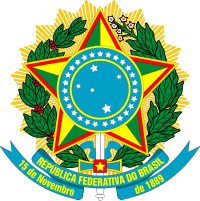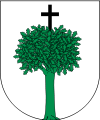- Coat of arms of Brazil
-
Coat of arms of Brazil 
Details Armiger  The Federative Republic of Brazil
The Federative Republic of BrazilAdopted November 19, 1889 Crest Green and yellow star Escutcheon Round shield with silver stars Supporters Stalks of coffee and tobacco Other elements Sword,
names "República Federativa do Brasil" and "15 de novembro de 1889"The coat of arms of Brazil was created on November 19, 1889, four days after Brazil became a republic.
The coat of arms consists of the central emblem surrounded by coffee (at the left) and tobacco (at the right) branches, which were important crops in Brazil at that time.
In the blue circle in the center, the Southern Cross (Portuguese: Cruzeiro do Sul) can be seen. The ring of 27 stars around it represents Brazil's 26 states and the Federal District.
The blue ribbon contains the official name of Brazil (República Federativa do Brasil — Federative Republic of Brazil) in its first line. In the second line, the date of the federative republic's establishment (November 15, 1889) is written.
Contents
National arms
The National Arms of the Republic were instituted by Decree No. 4, with alteration made by Law No. 5443 of 28 May 1968 (Annex No. 8) The making of the National Arms should conform to the proportions of 15 units of height by 14 of width and take into account the following provisions:
- I - The round shield will be composed of a sky-blue [azul-celeste] field containing five silver [prata] stars arranged in the form of the Southern Cross, with the bordure [bordura] of the field outlined in gold and charged with silver stars equal to the stars existing in the National Flag (Modification made by Law No. 8421 of 11 May 1972).
- II - The shield will be placed on a star parted gyronny of ten pieces, green [sinopla] and gold, bordered by two strips, the inner red [goles] and the outer gold.
- III - All placed on a sword in pale, pommelled gold, hilted blue [blau], except for the center part, which is red [goles] and contains a silver star, all upon a crown formed by a branch of coffee fruited on the dexter side and another of flowering tobacco on the sinister side, both in proper colors, tied blue [blau], the whole assembled on a splendor of gold, the contours of which form a star of 20 points.
- IV - On a blue [blau] scroll, placed over the pommel of the sword, inscribed in gold the legend "República Federativa do Brasil" in the center, and also the phrases "15 de Novembro" on the dexter end and "de 1889" on the sinister end
Arms of the Empire of Brazil
The Arms of the Empire of Brazil were used by both Emperors Pedro I and Pedro II until the downfall of the monarchy in 1889. These arms (with modifications) are used by the present imperial house.
On 18 September 1822, eleven days after proclaiming Brazil's independence Royal Prince Dom Pedro signed a decree instituting these arms stating "...henceforth the arms of this Empire of Brazil will be, on a green field, a gold armillary sphere superimposed on a cross of the Order of Christ, the sphere encircled by 19 silver stars on a blue circle; and an imperial crown with diamonds set atop the shield, the sides of which will be embraced by two plants of coffee and tobacco, as emblems of its [the Empire's] riches, in their proper colors and tied at the bottom with the national bow-knot."[1]
On 12 October 1822 when the newly independent country was declared an Empire and Prince Pedro became the country's first emperor, the coat of arms became known as the Imperial Coat of Arms.[2]
The number of stars in the coat of arms reflected the number of provinces in the Brazilian Empire.
The design of the Crown in the coat of arms changed twice. From 18 September to 12 October 1822, the day when Emperor Dom Pedro I was crowned, the design of the Royal Crown of Portugal was used; from that day until 18 July 1841, the design of the Imperial Crown made for the first Brazilian Emperor was used.
On the latter date, when Brazil's second emperor, Pedro II was crowned, using a new richer crown that was manufactured for him, the design of such Crown replaced the image of the older diadem in the coat of arms, and remained in use until the downfall of the Empire. That is the best known version of the imperial coat of arms of Brazil.
-
Coat of arms of the Colonial Brazil, (1500-1815)
-
Coat of arms of the United Kingdom of Portugal, Brazil and Algarves, (1816-1821)
-
Imperial Coat of arms, design of the first reign (note the crimson velvet within the Crown), kept in usage in the early second reign, until the Coronation of Emperor Pedro II (when the design of the Crown was modified, to reflect the shape of the new Crown, and its dark green velvet cap, December 1, 1822 - July 18, 1840
-
Imperial Coat of arms, complete version, design of the second reign (1840-1889). A simplified version was also used. The simplified version was equal to the coat of arms of the first reign, except for the dark green colour of the Crown's cap and the Crown's shape. Thus, the simplified version of the coat of arms contained only the shield surmounted by a Crown and surrounded by branches of coffee and tobacco, united by a red ribbon. Only the complete version included the other elements: the Order of the Southern Cross, the Sceptre and Hand of Justice crossed behind the shield, and the cloth of estate surmounted by a second Crown.
See also
- Brazil
- Coat of arms
- Coat of arms of Dutch Brazil
- Coats of Brazilian states
External links
References
National symbols of Brazil Official Other Sovereign states Dependencies and
other territoriesCategories:- National symbols of Brazil
- National coats of arms
- Brazilian coats of arms
- Southern Cross Flags
Wikimedia Foundation. 2010.





